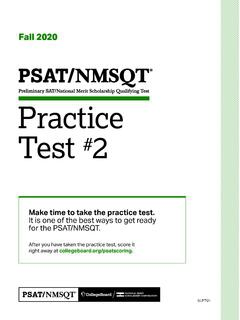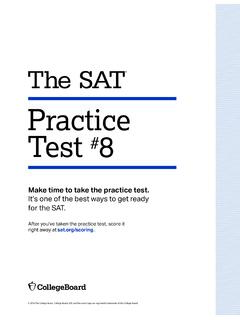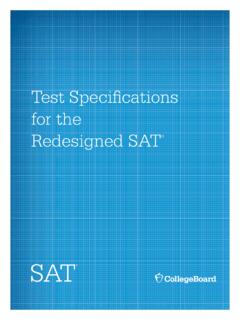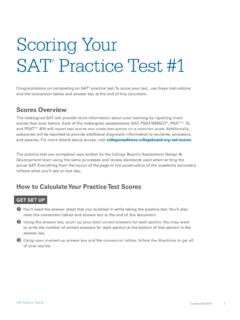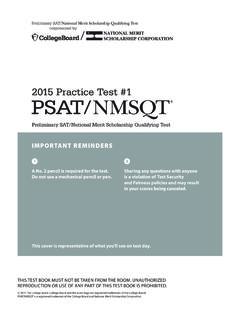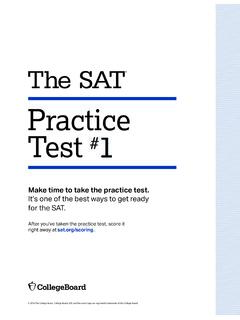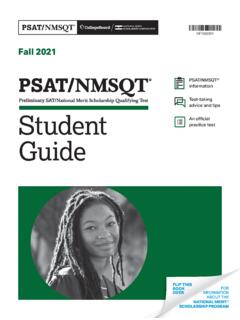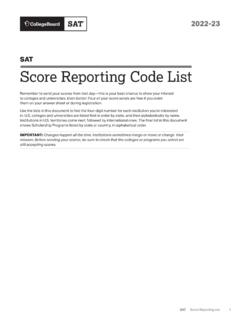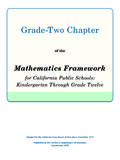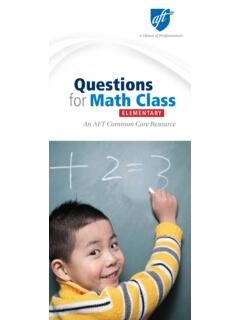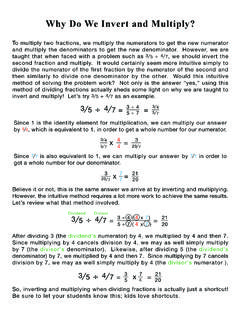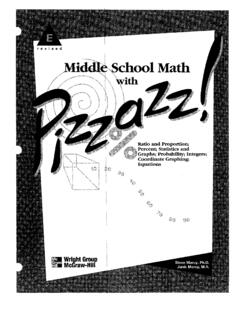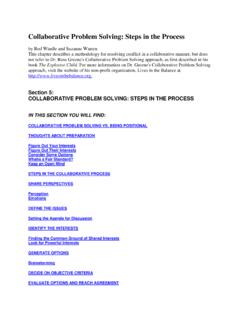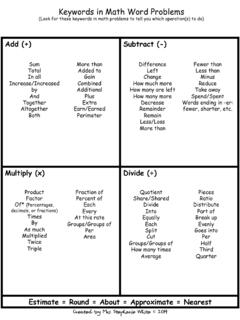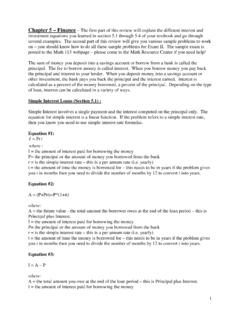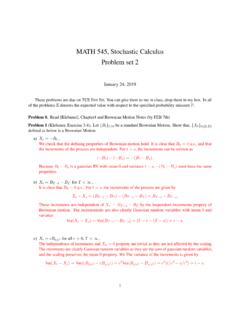Transcription of CHAPTER 17 Problem Solving and Data Analysis
1 209 CHAPTER 17 Problem Solving and data AnalysisThe Problem Solving and data Analysis questions on the SAT math Test assess your ability to use your understanding of math and your skills to solve problems set in the real world. The questions ask you to create a representation of a Problem , consider the units involved, pay attention to the meaning of quantities, know and use different properties of mathematical operations and representations, and apply key principles of statistics and probability. Special focus in this domain is given to mathematical models. Models are representations of real-life contexts. They help us to explain or interpret the behavior of certain components of a system and to predict results that are as yet unobserved or unmeasured.
2 You may be asked to create and use a model and to understand the distinction between the predictions of a model and the data that has been questions involve quantitative reasoning about ratios, rates, and proportional relationships and may require understanding and applying unit rates. Some problems are set in academic and career settings and draw from science, including the social questions present information about the relationship between two variables in a graph, scatterplot, table, or another form and ask you to analyze and draw conclusions about the given information. These questions assess your understanding of the key properties of, and the differences between, linear, quadratic, and exponential relationships and how these properties apply to the corresponding real-life Solving and data Analysis also includes questions that assess your understanding of essential concepts in statistics and probability.
3 You may be asked to analyze univariate data ( data involving one variable) presented in dot plots, histograms, box plots, and frequency tables, or bivariate data ( data involving two variables) presented in scatterplots, line graphs, and two-way tables. This includes computing, comparing, and interpreting measures of center, interpreting measures of spread, describing overall patterns, and recognizing the effects of outliers on measures of center and spread. These questions may test your understanding of the conceptual meaning of standard deviation (although you will not be asked to calculate a standard deviation).PART 3 | Math210 Other questions may ask you to estimate the probability of an event, employing different approaches, rules, or probability models.
4 Special attention is given to the notion of conditional probability, which is tested using two-way tables and in other questions will present you with a description of a study and ask you to decide what conclusion is most appropriate based on the design of the study. Some questions ask about using data from a sample to draw conclusions about an entire population. These questions might also assess conceptual understanding of the margin of error (although you won t be asked to calculate a margin of error) when a population mean or proportion is estimated from sample data . Other questions ask about making conclusions about cause-and-effect relationships between two Solving and data Analysis questions include both multiple-choice questions and student-produced response questions.
5 The use of a calculator is allowed for all questions in this Solving and data Analysis is one of the three SAT math Test subscores, reported on a scale of 1 to s explore the content and skills assessed by Problem Solving and data Analysis Solving and data Analysis questions comprise 17 of the 58 questions (29%) on the math , Proportion, Units, and PercentageRatio and proportion is one of the major ideas in mathematics. Introduced well before high school, ratio and proportion is a theme throughout mathematics, in applications, in careers, in college mathematics courses, and 1On Thursday, 240 adults and children attended a show. The ratio of adults to children was 5 to 1.
6 How many children attended the show?A) 40B) 48C) 192D) 200 Because the ratio of adults to children was 5 to 1, there were 5 adults for every 1 child. Thus, of every 6 people who attended the show, 5 were adults and 1 was a child. In fractions, 5 _ 6 of the 240 who attended were adults and _ 6 1 were children. Therefore, 1 _ 6 240 = 40 children attended the show, which is choice on the SAT may be expressed in the form 3 to 1, 3:1, 3_1 , or simply ratio represents a relationship between quantities, not the actual quantities themselves. Fractions are an especially effective way to represent and work with 17 | Problem Solving and data Analysis211 Example 2On an architect s drawing of the floor plan for a house, 1 inch represents 3 feet.
7 If a room is represented on the floor plan by a rectangle that has sides of lengths inches and 5 inches, what is the actual floor area of the room, in square feet?A) ) ) ) 1 inch represents 3 feet, the actual dimensions of the room are 3 = feet and 3 5 = 15 feet. Therefore, the floor area of the room is 15 = square feet, which is choice classic example of ratio is the length of a shadow. At a given location and time of day, it might be true that a fence post that has a height of 4 feet casts a shadow that is 6 feet long. This ratio of the length of the shadow to the height of the object, 6 to 4 or 3 to 2, remains the same for any object at the same location and time.
8 This could be considered a unit rate: the ratio of the length of the shadow to the height of the object would be equivalent to _ 2 3to 1 or the unit rate 3 _ 2 feet change in length of shadow for every 1 foot change in height of the object. So, for example, a tree that is 12 feet tall would cast a shadow that is 3 _ 2 12 = 18 feet long. In this situation, in which one variable quantity is always a fixed constant times another variable quantity, the two quantities are said to be directly x and y are said to be directly proportional if y = kx, where k is a nonzero constant. The constant k is called the constant of the preceding example, you would say the length of an object s shadow is directly proportional to the height of the object, with constant of proportionality 3_2.
9 So if y ou let L be the length of the shadow and H be the height of the object, then L = 3 _ 2H .Notice that both L and H are lengths, so the constant of proportionality, L _ H = 3_2 , has no units . In contrast, let s consider Example 2 again. On the scale drawing, 1 inch represents 3 feet. The length of an actual measurement is directly proportional to its length on the scale drawing. But to find the constant of proportionality, you need to keep track of units: 3 feet _ 1 inch= 36 inches _ 1 inch = 36 . Hence, if S is a length on the scale drawing that corresponds to an actual length of R, then R = 36S, where R and S have the same of the questions on the SAT math Test require you to pay attention to units.
10 Some questions in Problem Solving and data Analysis require you to convert units either between the English system and the metric system or within those 3 | Math212 Example 3 Scientists estimate that the Pacific Plate, one of Earth s tectonic plates, has moved about 1,060 kilometers in the past million years. About how far, in miles, has the Pacific Plate moved during this same time period? (Use 1 mile = kilometers.)A) 165B) 398C) 663D) 1,696 Because 1 mile = kilometers, the distance is 1,060 kilometers 1 mile kilometers = miles, which is about 663 miles. Therefore, the correct answer is choice may require you to move between unit rates and total close attention to units, and convert units if required by the question.
